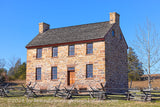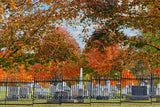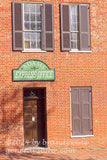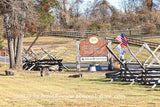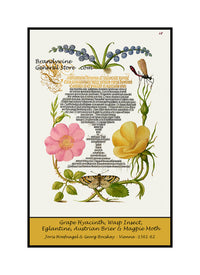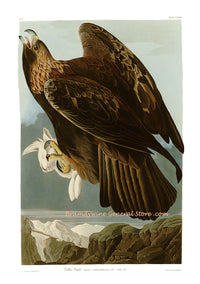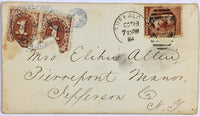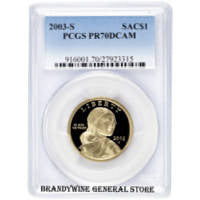Ground Dove by John James Audubon art print
An archival premium Quality art Print of the Ground Dove by John James Audubon for sale by Brandywine General Store. In this bird painting the artist shows a small flock of these beautiful birds which are all perched in a wild orange tree. The coloring of these doves is mostly browns and rusty reds and some black borders on the edges of the wings and tails. This bird is only found in the lower southern sections of the United States and is in decline in numbers. They are mostly permanent residents of the areas in which they live, however in some sections they will migrate a short distance. They like to walk through the brush and eat seeds on farmsteads, orchards and at the edge of the woodlands. If startled they will make a terrific noise and then fly up into the trees. The Ground Dove was picture or plate number 182 in the first Havell edition of the Birds of America.
Columba Passerina - Mr. Audubon gives the following account of the Ground Dove in his book, The Birds of America. If the different species of Pigeons and Doves which I have described, have interested you sufficiently to render you desirous of holding further converse with that interesting family, and of examining for yourself, which I sincerely wish you would resolve to do, you may perhaps visit the islands, which, like so many bastions, protect the shores of South Carolina, Georgia, and the Floridas, those spots where, in the calm of every spring morn, the air is rendered balmy by the effluvia of thousands of flowers, each of which rivals its neighbour in the brilliancy of its hues. Stop there, kind reader, and seat yourself beneath the broadly extended arms of the thickly-leaved evergreen oak, and at that joyous moment when the first beams of the sun reach your eye, see the Owl passing low and swiftly over the ground, in haste to reach his diurnal retreat before the increasing light render all things dim to his sight; observe the leathern-winged Bat, pursuing his undulating course through the dewy air, now deflecting downwards to seize the retiring nocturnal insect, now upwards to pursue another species, as it rises to meet the genial warmth emitted by the orb of day. Listen,--for at such a moment your soul will be touched by sounds,--to the soft, the mellow, the melting accents, which one might suppose inspired by Nature's self, and which she has taught the Ground Dove to employ in conveying the expression of his love to his mate, who is listening to them with delight.
Before I proceed to describe the habits of this interesting bird, allow me to present you with the result of my observations relative to the geographical distribution of the birds of the genus Columba, which are either resident in the United States or visit them annually. The Passenger Pigeon ranges over the whole of the United States, excepting perhaps the southernmost portions of the Floridas, and extends to Newfoundland, where it is well known. The Carolina Dove ranges from Louisiana to the middle parts of the State of Massachusetts, but is never seen in Maine. It reaches up the Mississippi as far as Prairie du Chien, and in that direction extends to the borders of Upper Canada. The Ground Dove is met with from the lower parts of Louisiana to Cape Hatteras, following the coast quite round the Floridas, but very seldom seen at any great distance in the interior. It is unknown in the State of Mississippi; and I will venture to add, that one of these birds has never been seen in Kentucky, although some writers have alleged that they occur there. They are more abundant on the sea islands of Georgia, and the middle portions of the coast of East Florida, than any where else. A search for them a hundred miles inland would in all probability prove fruitless. The White-headed Pigeon is confined to about three hundred miles of the Florida Keys. It seldom, if ever, visits the mainland. It remains with us about seven months of the year. The Zenaida Dove seldom reaches farther east, along the Florida Keys, than Cape Light-House. It never visits the Main. Its residence with us is shorter than that of the White-headed Pigeon by a full month. The Key West Pigeon has never been met with elsewhere than on the island of that name. It remains there about five months only. The same is the case with the Blue-headed Ground Pigeon, commonly called the Cuba Partridge, which is the rarest of all the species known to me that resort to the Floridas.
In the above account, I have placed the species according to the number of individuals of each that occur in our country, beginning with the Passenger Pigeon, which is the most numerous, and ending with the Blue-headed Pigeon, which is the rarest; and I beg of you, kind reader, to recollect that hear-say has no part as a foundation for the results in this statement. I may also inform you, that curiosity, in part, prompted me to present it, it having been written in 1832, with the view of seeing if any of these birds shall become more or less numerous, or extend or diminish their range.
The flight of the Ground Dove is low, easy, and accompanied with a whistling sound, produced by the action of the wings, when the bird is surprised and forced to fly. It is less protracted than that of any other species with which I am acquainted in the United States, with the exception of the Blue-headed Pigeon. The crossing of the Gulf Stream by the latter bird is more surprising than the extended flight of the European Quail. The Ground Dove seldom flies more than a hundred yards at a time, and indeed is extremely attached to the spot which it has selected for the season. You may drive it to the opposite end of a large field, and yet, in a few hours after, it may be found in the place whence you raised it. Although it alights on trees or low bushes, on the branches of which it walks with ease, and on which its nest is most frequently placed, the ground is its usual resort. There it runs with facility, keeping its tail considerably elevated, as if to save it from being soiled. It is also fond of alighting on fences, where it is easily observed, and where it may be heard cooing for half an hour at a time.
These Pigeons are met with in groups of four or five, and it is seldom that more than a dozen are seen together. They prefer the thinly grassed sandy portions of cotton fields, pea-patches, and such places. In East Florida they are seen in the villages, and resort to the orange groves about them, where they frequently breed. I have often found them in the inner court of the famous Spanish fort of St. Augustine, where I have been surprised to see them rise almost perpendicularly, to reach above the parapets, by which they insured their escape. They are easily caught in traps, and at that place are sold at 6 1/4 cents each. They readily become domesticated, and indeed so very gently are they, that I have seen a pair which, having been caught at the time when their young were quite small, and placed in an aviary, at once covered the little ones, and continued to nourish them until full-grown. They afterwards raised a second brood in the same nest, and shewed great spirit in keeping the Jays and Starlings from their charge. In this aviary, which belonged to Dr. WILSON of Charleston, several other species bred, among which were the Carolina Dove, the Cardinal-bird, the Blue Grosbeak, the White-throated Sparrow, the Towhe Bunting, the Common Partridge, and the Wood Duck. The Ground Doves were fed on rice and other small grain.
The nest of this species is large for the size of the bird, and compact. Its exterior is composed of dry twigs, its interior of grasses disposed in a circular form. It is usually placed in low bushes or hedges, or in orange-trees in orchards. Early in April the female deposits her two pure white eggs; and sometimes three, but more generally two broods are reared in a season. The male struts before the female in the manner of the Barbary Ringed Dove. A few of these birds remain all the year in the vicinity of Charleston, but the greater number retire either to the sea islands or to the Floridas. I met with them on the Keys resorted to by the Zenaida Dove, and saw some on Sandy Island, which lies six miles south from Cape Sable, the extreme point of the peninsula. They were so gentle that I approached them within less than two yards. Their nest was placed on the top of a cactus, not more than two feet high. I took some pleasure in destroying a pair of Fish Crows, that were waiting an opportunity to deprive them of their young.
This beautiful Pigeon is rarely met with to the westward of the mouths of the Mississippi, along the coast of the Gulf of Mexico. None were seen on our way to the Texas. The eggs measure seven and a half eighths of an inch by rather more than five-eighths, and are thus of an elongated form. In a wild state, the food of this species consists of grass-seeds and various small berries, with which they pick up a large proportion of gravel to assist digestion. They are extremely fond of dusting themselves in the sand, lying down upon it for a long time, in the manner of Partridges and other Gallinaceous birds, to which indeed they are closely allied. Their flesh is excellent. Audubon bird print #182



